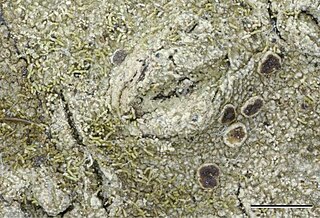
Carl Schmitt was a German jurist, political theorist, geopolitician and prominent member of the Nazi Party.

Emerita is a small genus of decapod crustaceans, known as mole crabs, sand fiddlers, or sand crabs. These small animals burrow in the sand in the swash zone and use their antennae for filter feeding.

Mary Jane Rathbun was an American zoologist who specialized in crustaceans. She worked at the Smithsonian Institution from 1884 until her death. She described more than a thousand new species and subspecies and many higher taxa.

Chlorocebus is a genus of medium-sized primates from the family of Old World monkeys. Six species are currently recognized, although some people classify them all as a single species with numerous subspecies. Either way, they make up the entirety of the genus Chlorocebus.

The Parmeliaceae is a large and diverse family of Lecanoromycetes. With over 2700 species in 71 genera, it is the largest family of lichen-forming fungi. The most speciose genera in the family are the well-known groups: Xanthoparmelia, Usnea, Parmotrema, and Hypotrachyna.

Kurt Paul Schmitt was a German jurist versed in economic matters. A supporter of the Nazis since 1930, he joined the Nazi party in 1933, becoming also an honorary SS. He presided over Allianz insurance company, and was the Reich Economy Minister from 1933 to 1934. His antisemitic views let him believe that the role Jews played in politics, law and the arts was excessive, and had to be drastically curtailed if not totally eliminated.

The Coelopidae or kelp flies are a family of Acalyptratae flies, they are sometimes also called seaweed flies, although both terms are used for a number of seashore Diptera. Fewer than 40 species occur worldwide. The family is found in temperate areas, with species occurring in the southern Afrotropical, Holarctic, and Australasian regions.

Palaemonidae is a family of shrimp in the order Decapoda. Many species are carnivores that eat small invertebrates, and can be found in any aquatic habitat except the deep sea. One significant genus is Macrobrachium, which contains commercially fished species. Others inhabit coral reefs, where they associate with certain invertebrates, such as sponges, cnidarians, mollusks, and echinoderms, as cleaner shrimps, parasites, or commensals. They generally feed on detritus, though some are carnivores and hunt tiny animals.

Camaenidae is a family of air-breathing land snails, terrestrial pulmonate gastropod mollusks in the superfamily Helicoidea, the typical snails and their allies. This is one of the most diverse families in the clade Stylommatophora.

Squilla is a genus of mantis shrimp. It includes the following species:

Georissus, also called minute mud-loving beetles, is the only genus in the beetle family Georissidae. They are tiny insects living in wet soil, often near water. They are found on every continent except Antarctica.
Tetrasquilla is a genus of mantis shrimp containing a single species, Tetrasquilla mccullochae. It is the only known pantropical stomatopod. The specific epithet commemorates Dr. Irene A. McCulloch, professor of zoology of the University of Southern California.

The Aeglidae are a family of freshwater crustaceans currently restricted to South America. They are the only anomurans to be found in fresh water except for a single hermit crab species, Clibanarius fonticola, on Espiritu Santo, Vanuatu. They live between 20° S and 50° S, at altitudes between 320 and 3,500 m (1,050–11,480 ft).

Raphitoma is a genus of sea snails, marine gastropod mollusks in the family Raphitomidae.

Callichirus is a genus of crustaceans belonging to the family Callianassidae. It was circumscribed by William Stimpson in 1866.

Neoprotoparmelia is a genus of crustose lichens that was created in 2018. It contains 24 tropical and subtropical species that mostly grow on bark. Neoprotoparmelia is in the subfamily Protoparmelioideae of the family Parmeliaceae, along with the morphologically similar genera Protoparmelia and Maronina.

Varicellaria is a genus of crustose lichens. It is the only genus in the family Varicellariaceae.
Gyalectaria is a genus of crustose lichens in the family Coccotremataceae. It has three species. The genus was circumscribed in 2010 by Imke Schmitt, Klaus Kalb and Helge Thorsten Lumbsch, with G. jamesii assigned as the type species. The three species transferred to the genus were originally placed in the large genus Pertusaria. Molecular phylogenetics showed that they belong to a lineage distinct from and unrelated to that genus, but with a sister group relationship to the genus Coccotrema. The genus name combines Gyalect- and -aria, taken from the generic name Pertusaria.

Laomediidae is a family of mud shrimp crustaceans belonging to the infraorder Gebiidea, within the order Decapoda.

Lepra is a genus of lichen-forming fungi in the family Pertusariaceae. Although the genus was created in 1777, it was not regularly used until it was resurrected in 2016 following molecular phylogenetic analyses. It has more than a hundred species, most of which were previously classified in genus Pertusaria.


















